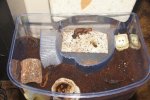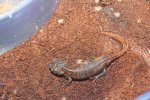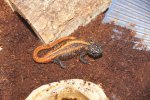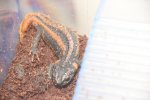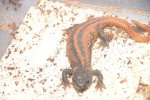End
New member
- Joined
- Jul 21, 2009
- Messages
- 95
- Reaction score
- 2
- Points
- 0
- Country
- Italy
- Display Name
- luca
Three weeks ago i bought a pair of T.Kweichowensis (they looks like 2 female to me but i'm far away to be an expert on sexing tylototriton). They come from the pet store where i work , my "boss" bought them from his exotic animals dealer , he took some other caudates from him , C.pyrrhogaster - C. ensicauda ensicauda and some Cyanurus, this thing was absolutely strange for me because the only amphibians he usually took for the store are Bombina orientalis Cynops Orientalis and Ambystoma tigrinum , so i have started to investigate and after a couple of question and some phone calls i know almost for sure that this animals come from the last Hamm show in september.
I dont know if this animals are wc or cb , they are in good condition and are voracious eater , anyway now the reason why i opened this thread, they looks quite different to the other Kweichowensis i saw around the net and especially here , as you can see from the pics the two orange lines that run along the dorsal area are not fused but clearly separeted and more "bumpy", also the tail look different , it's alot less laterally compressed and look more rounded .
About the tail, maybe this could be because they are 100% terrestrial at the moment , but i saw many pics of freshly morphed terrestrial Kweichowensis with more high and laterally compressed tail...so i guess this make no sense.
If any of you have this kinda of Kweichowensis(if they are really different) have you noticed any difference in set-up preference ? mine seems to ignore completely the water , i keep them in 50%land 50%water
now the pics



I dont know if this animals are wc or cb , they are in good condition and are voracious eater , anyway now the reason why i opened this thread, they looks quite different to the other Kweichowensis i saw around the net and especially here , as you can see from the pics the two orange lines that run along the dorsal area are not fused but clearly separeted and more "bumpy", also the tail look different , it's alot less laterally compressed and look more rounded .
About the tail, maybe this could be because they are 100% terrestrial at the moment , but i saw many pics of freshly morphed terrestrial Kweichowensis with more high and laterally compressed tail...so i guess this make no sense.
If any of you have this kinda of Kweichowensis(if they are really different) have you noticed any difference in set-up preference ? mine seems to ignore completely the water , i keep them in 50%land 50%water
now the pics




